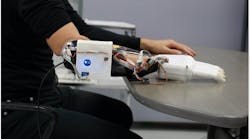Prosthetic Hand Controlled by AI and Patient’s Thoughts
Researchers at the Biological Systems Engineering Lab at Hiroshima University have developed a 3D-printed prosthetic hand combined with a computer interface, which is their least expensive, lightest model and it is more reactive to motion intent than before. Previous generations of their prosthetic hands have been made of metal, which is heavy and expensive to make.
Professor Toshio Tsuji of the Graduate School of Engineering, Hiroshima University describes the mechanism of this new hand and computer interface using a game of “rock, paper, scissors.” The wearer imagines a hand movement, such as making a fist for rock or a peace sign for scissors, and the computer attached to the hand combines the previously learned movements of all five fingers to make this motion.
Electrodes in the socket of the prosthetic measure electrical signals from nerves through the skin similar to how ECGs measure heart rate. The signals return to the computer, which only takes five milliseconds to make its decision about what movement it generate. The computer then sends the (hopefully) appropriate electrical signals to the motors in the hand.
The neural network (named Cybernetic Interface) that allows the computer to “learn” was trained to recognize movements from each of the five fingers and then combine them into different patterns to turn scissors into rock, pick up a water bottle, or to control the force used to shake someone’s hand.
The lab tested the equipment with patients and worked with Kinki Gishi to develop the socket to accommodate the amputee patients’ arm.
Seven participants were recruited for this study, including one amputee who had worn a prosthesis for 17 years. Participants were asked to perform a variety of tasks with the hand that simulated daily life, such as picking up small items, or clenching their fist. The accuracy of prosthetic hand movements measured in the study for single simple motion was above 95 %, and complicated, unlearned motions was 93%.
However, this hand is not quite ready for all wearers. Using the hand for a long time can be burdensome for the wearer as they must concentrate on the hand position in order to sustain it, which causes muscle fatigue. The team are planning on creating a training plan to make the best use of the hand and hope it will become an affordable alternative on the prosthetics market.

